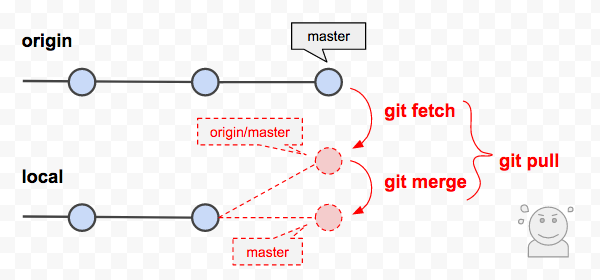

- #Git pull vs fetch for free#
- #Git pull vs fetch how to#
- #Git pull vs fetch update#
- #Git pull vs fetch manual#
# Be careful with this next command: make sure "git status" is M-N-O-P-Q ("master" and "dubious-experiment")

Then you separate out your work with the following set of commands (where the diagrams show how the state has changed after them): git branch dubious-experiment If the commit graph looks like this: last version from another repository When merging with git merge, you only specify the branch you want to merge into the current one, and only your current branch advances.Īnother common situation where this view of branches helps a lot is the following: suppose you’re working on the main branch of a project (called “master”, say) and realise later that what you’ve been doing might have been a bad idea, and you would rather it were on a topic branch. So now A, B, C, D, E, F, G and H are on “stable”, while A, B, D, F and I are on “new-idea”.īranches do have some special properties, of course – the most important of these is that if you’re working on a branch and create a new commit, the branch tip will be advanced to that new commit. If you carry on committing on “new idea” and on “stable”, you get: A-C-E-G-H ("stable") … then you have the following: A-C-E-G ("stable") If you then merge “new-idea” into “stable” with the following commands: git checkout stable # Change to work on the branch "stable" So the commits A, C and E are on “stable” and A, B, D and F are on “new-idea”. For example, suppose you have two branches, “stable” and “new-idea”, whose tips are at revisions E and F: A-C-E ("stable") This definition has some perhaps unexpected implications. This means that manipulating them is a very lightweight operation – you just change that value. I would suggest that you think of branches in terms of what defines them: they’re a name for a particular commit and all the commits that are ancestors of it, so each branch is completely defined by the SHA1sum of the commit at the tip.


#Git pull vs fetch manual#
What seem like obvious bits of syntax for git pull may have rather surprising results, as even a cursory look through the manual page should convince you. Mostly things Just Work, but when they don’t it’s often difficult to work out why. The problem with git pull is that it has all kinds of helpful magic that means you don’t really have to learn about the different types of branch in git. One of the git tips that I find myself frequently passing on to people is:ĭon’t use git pull, use git fetch and then git merge. There is some discussion of this post on the git mailing list, but much of it is tangential to the points I’m trying to make here. Use Git's Stash feature to save your local changes temporarily.This is too long and rambling, but to steal a joke from Mark Twain Blaise Pascal I haven’t had time to make it shorter yet. This means that you should not have any uncommitted local changes before you pull. Like for many other actions, it's highly recommended to start a "git pull" only with a clean working copy.
#Git pull vs fetch how to#
Check out our in-depth tutorial on How to deal with merge conflicts for more information. Since "git pull" tries to merge remote changes with your local ones, a so-called "merge conflict" can occur.This means that pull not only downloads new data it also directly integrates it into your current working copy files.
#Git pull vs fetch update#
Git pull, in contrast, is used with a different goal in mind: to update your current HEAD branch with the latest changes from the remote server. This means you can never fetch often enough. Fetch is great for getting a fresh view on all the things that happened in a remote repository.ĭue to it's "harmless" nature, you can rest assured: fetch will never manipulate, destroy, or screw up anything. Git fetch really only downloads new data from a remote repository - but it doesn't integrate any of this new data into your working files.
#Git pull vs fetch for free#
Download Now for Free Fetch $ git fetch origin


 0 kommentar(er)
0 kommentar(er)
